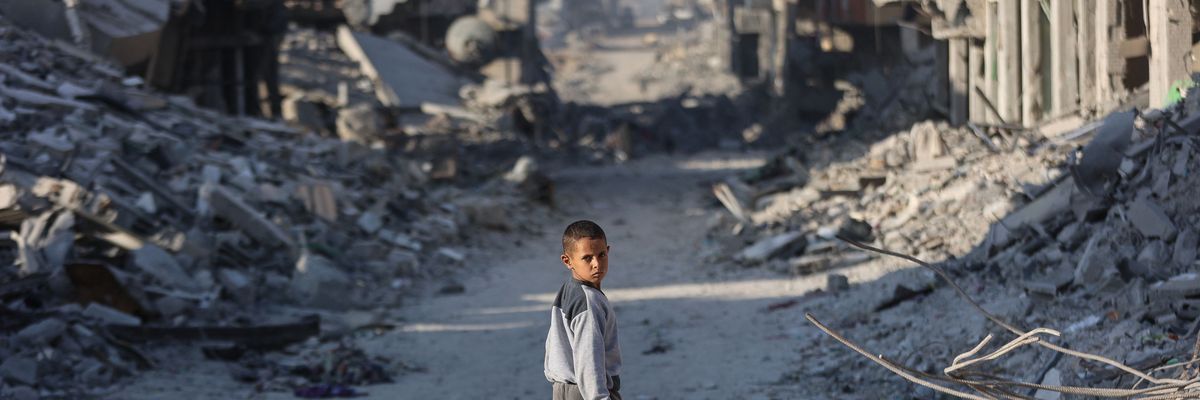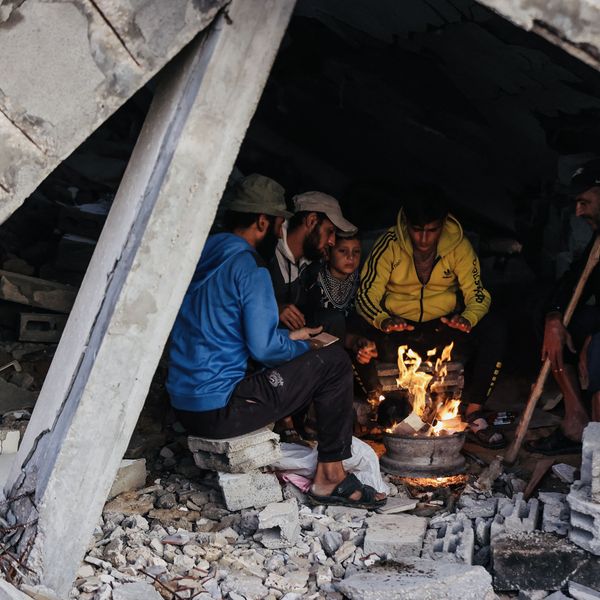
A Palestinian boy walks past the rubble of destroyed buildings in the Sheikh Radwan neighborhood of Gaza City on October 22, 2025.
A Minefield in Gaza
After two years of relentless bombardment, what Israel's military has left behind in Gaza will continue to claim lives and maim the innocent.
After two years of unrelenting war, the world breathed a sigh of relief on October 9 as the first phase of Trump’s 20 point plan for Gaza went into effect. But, on October 13, while hostage release celebrations were taking place in Israel, the West Bank, and Gaza, five children playing amid the rubble near Al-Shifa hospital were injured, two severely, when an unexploded ordinance (UXO) went off.
In December 2023, only two months into the war, the Wall Street Journal called Israel’s actions in Gaza the "most devastating urban warfare in the modern record”. By April 2024, Euromed estimated that Israel had dropped over 70,000 tons of explosives on the area, an amount exceeding all of the bombs dropped on London, Dresden, and Hamburg throughout World War II. This month, as the fragile ceasefire came into effect, the Gaza Government of Media office estimated the tonnage to be 200,000, the equivalent of thirteen Hiroshimas.
According to the UN Mine Action Service (UNMAS), around 5% to 10% of the munitions used by Israel in the war in Gaza failed to detonate on impact. But, the duds are far from innocuous. Like the anti-personnel and anti-tank landmines being used right now in Ukraine and Myanmar, the UXO lie in wait, seemingly innocuous, ready to kill or maim whoever, soldier or civilian, adult or child, is unfortunate enough to come upon them.
The first widespread use of landmines occurred during the American Civil War, when the Confederate army invented and instituted them as an affordable way to compensate for shortages of resources and manpower. An immediate debate arose on the ethics of their use.
In WWI, an extensive number of anti-tank landmines were laid by the Germans. When the Armistice Agreement was signed in 1918, it obligated Germany to provide the locations of the mines and assist in their removal.
In WWII, landmines were used heavily by both sides. After Germany lost the war, their POWs were forced by Allied troops to undertake the extensive and dangerous job of removing the mines. In Denmark, around 1,000 Germans, many of them mere teenagers, were either killed or maimed in the process.
1.5 million mines were laid during the 1967 war by Israeli, Jordanian, and Syrian forces. It wasn’t until 2011, following the tragedy of an 11-year-old Jewish-Israeli boy losing his leg after tripping a leftover mine while playing outside his home in the Golan Heights, that cleanup efforts began in earnest.
In 1992, Human Rights Watch and five other NGOs launched the International Campaign to Ban Landmines (ICBL), and in 1997, the Convention on the Prohibition of the Use, Stockpiling, Production and Transfer of Anti-Personnel Mines and on their Destruction (known informally as the Ottawa or Mine Ban Treaty) was signed by 122 countries.
Today, 165 countries, more than three-quarters of the world’s states, are party to the convention. Jordan joined in 1998, and Palestine in 2017. Israel, however, insists that, due to security needs, they are unable to commit to a total ban on landmines.
Although the last verified use of landmines by Israel was in 2011 (they have denied media reports that they used anti-personnel mines to seal off the Gaza border right after Hamas’s October 7 attack), their actions over the past two years have turned the Gaza Strip into a dense, unmapped minefield.
According to the aid group, Humanity and Inclusion, surface clearance of UXO in Gaza could be accomplished in 20 to 30 years, but full clearance, to get to the UXO buried deep underground, will take generations. The organization is ready to send a seven-person team of experts into the enclave to begin identifying the UXO in such essential places as hospitals and bread bakeries. Unfortunately, Israel has yet to give them permission to start their work and has refused to allow the equipment to decommission and remove the UXO, due to it being considered “dual use,” having both civilian and military potential.
As Human Rights Watch has articulated, the United States is a party to the conflict in Gaza, providing weapons, intelligence, and even direct participation in the war, and as such, the US is responsible under international law for aiding and assisting in internationally wrongful acts “with knowledge of the circumstances.” They have been calling for an end to arms sales and military assistance to Israel, targeted sanctions on Israeli officials, and the suspension of preferential trade agreements with Israel. These actions will be necessary if we are going to be able to stop the creation of more UXO and begin the process of clearing the territory so that it is again habitable for children and other living things.
An Urgent Message From Our Co-Founder
Dear Common Dreams reader, The U.S. is on a fast track to authoritarianism like nothing I've ever seen. Meanwhile, corporate news outlets are utterly capitulating to Trump, twisting their coverage to avoid drawing his ire while lining up to stuff cash in his pockets. That's why I believe that Common Dreams is doing the best and most consequential reporting that we've ever done. Our small but mighty team is a progressive reporting powerhouse, covering the news every day that the corporate media never will. Our mission has always been simple: To inform. To inspire. And to ignite change for the common good. Now here's the key piece that I want all our readers to understand: None of this would be possible without your financial support. That's not just some fundraising cliche. It's the absolute and literal truth. We don't accept corporate advertising and never will. We don't have a paywall because we don't think people should be blocked from critical news based on their ability to pay. Everything we do is funded by the donations of readers like you. Will you donate now to help power the nonprofit, independent reporting of Common Dreams? Thank you for being a vital member of our community. Together, we can keep independent journalism alive when it’s needed most. - Craig Brown, Co-founder |
After two years of unrelenting war, the world breathed a sigh of relief on October 9 as the first phase of Trump’s 20 point plan for Gaza went into effect. But, on October 13, while hostage release celebrations were taking place in Israel, the West Bank, and Gaza, five children playing amid the rubble near Al-Shifa hospital were injured, two severely, when an unexploded ordinance (UXO) went off.
In December 2023, only two months into the war, the Wall Street Journal called Israel’s actions in Gaza the "most devastating urban warfare in the modern record”. By April 2024, Euromed estimated that Israel had dropped over 70,000 tons of explosives on the area, an amount exceeding all of the bombs dropped on London, Dresden, and Hamburg throughout World War II. This month, as the fragile ceasefire came into effect, the Gaza Government of Media office estimated the tonnage to be 200,000, the equivalent of thirteen Hiroshimas.
According to the UN Mine Action Service (UNMAS), around 5% to 10% of the munitions used by Israel in the war in Gaza failed to detonate on impact. But, the duds are far from innocuous. Like the anti-personnel and anti-tank landmines being used right now in Ukraine and Myanmar, the UXO lie in wait, seemingly innocuous, ready to kill or maim whoever, soldier or civilian, adult or child, is unfortunate enough to come upon them.
The first widespread use of landmines occurred during the American Civil War, when the Confederate army invented and instituted them as an affordable way to compensate for shortages of resources and manpower. An immediate debate arose on the ethics of their use.
In WWI, an extensive number of anti-tank landmines were laid by the Germans. When the Armistice Agreement was signed in 1918, it obligated Germany to provide the locations of the mines and assist in their removal.
In WWII, landmines were used heavily by both sides. After Germany lost the war, their POWs were forced by Allied troops to undertake the extensive and dangerous job of removing the mines. In Denmark, around 1,000 Germans, many of them mere teenagers, were either killed or maimed in the process.
1.5 million mines were laid during the 1967 war by Israeli, Jordanian, and Syrian forces. It wasn’t until 2011, following the tragedy of an 11-year-old Jewish-Israeli boy losing his leg after tripping a leftover mine while playing outside his home in the Golan Heights, that cleanup efforts began in earnest.
In 1992, Human Rights Watch and five other NGOs launched the International Campaign to Ban Landmines (ICBL), and in 1997, the Convention on the Prohibition of the Use, Stockpiling, Production and Transfer of Anti-Personnel Mines and on their Destruction (known informally as the Ottawa or Mine Ban Treaty) was signed by 122 countries.
Today, 165 countries, more than three-quarters of the world’s states, are party to the convention. Jordan joined in 1998, and Palestine in 2017. Israel, however, insists that, due to security needs, they are unable to commit to a total ban on landmines.
Although the last verified use of landmines by Israel was in 2011 (they have denied media reports that they used anti-personnel mines to seal off the Gaza border right after Hamas’s October 7 attack), their actions over the past two years have turned the Gaza Strip into a dense, unmapped minefield.
According to the aid group, Humanity and Inclusion, surface clearance of UXO in Gaza could be accomplished in 20 to 30 years, but full clearance, to get to the UXO buried deep underground, will take generations. The organization is ready to send a seven-person team of experts into the enclave to begin identifying the UXO in such essential places as hospitals and bread bakeries. Unfortunately, Israel has yet to give them permission to start their work and has refused to allow the equipment to decommission and remove the UXO, due to it being considered “dual use,” having both civilian and military potential.
As Human Rights Watch has articulated, the United States is a party to the conflict in Gaza, providing weapons, intelligence, and even direct participation in the war, and as such, the US is responsible under international law for aiding and assisting in internationally wrongful acts “with knowledge of the circumstances.” They have been calling for an end to arms sales and military assistance to Israel, targeted sanctions on Israeli officials, and the suspension of preferential trade agreements with Israel. These actions will be necessary if we are going to be able to stop the creation of more UXO and begin the process of clearing the territory so that it is again habitable for children and other living things.
After two years of unrelenting war, the world breathed a sigh of relief on October 9 as the first phase of Trump’s 20 point plan for Gaza went into effect. But, on October 13, while hostage release celebrations were taking place in Israel, the West Bank, and Gaza, five children playing amid the rubble near Al-Shifa hospital were injured, two severely, when an unexploded ordinance (UXO) went off.
In December 2023, only two months into the war, the Wall Street Journal called Israel’s actions in Gaza the "most devastating urban warfare in the modern record”. By April 2024, Euromed estimated that Israel had dropped over 70,000 tons of explosives on the area, an amount exceeding all of the bombs dropped on London, Dresden, and Hamburg throughout World War II. This month, as the fragile ceasefire came into effect, the Gaza Government of Media office estimated the tonnage to be 200,000, the equivalent of thirteen Hiroshimas.
According to the UN Mine Action Service (UNMAS), around 5% to 10% of the munitions used by Israel in the war in Gaza failed to detonate on impact. But, the duds are far from innocuous. Like the anti-personnel and anti-tank landmines being used right now in Ukraine and Myanmar, the UXO lie in wait, seemingly innocuous, ready to kill or maim whoever, soldier or civilian, adult or child, is unfortunate enough to come upon them.
The first widespread use of landmines occurred during the American Civil War, when the Confederate army invented and instituted them as an affordable way to compensate for shortages of resources and manpower. An immediate debate arose on the ethics of their use.
In WWI, an extensive number of anti-tank landmines were laid by the Germans. When the Armistice Agreement was signed in 1918, it obligated Germany to provide the locations of the mines and assist in their removal.
In WWII, landmines were used heavily by both sides. After Germany lost the war, their POWs were forced by Allied troops to undertake the extensive and dangerous job of removing the mines. In Denmark, around 1,000 Germans, many of them mere teenagers, were either killed or maimed in the process.
1.5 million mines were laid during the 1967 war by Israeli, Jordanian, and Syrian forces. It wasn’t until 2011, following the tragedy of an 11-year-old Jewish-Israeli boy losing his leg after tripping a leftover mine while playing outside his home in the Golan Heights, that cleanup efforts began in earnest.
In 1992, Human Rights Watch and five other NGOs launched the International Campaign to Ban Landmines (ICBL), and in 1997, the Convention on the Prohibition of the Use, Stockpiling, Production and Transfer of Anti-Personnel Mines and on their Destruction (known informally as the Ottawa or Mine Ban Treaty) was signed by 122 countries.
Today, 165 countries, more than three-quarters of the world’s states, are party to the convention. Jordan joined in 1998, and Palestine in 2017. Israel, however, insists that, due to security needs, they are unable to commit to a total ban on landmines.
Although the last verified use of landmines by Israel was in 2011 (they have denied media reports that they used anti-personnel mines to seal off the Gaza border right after Hamas’s October 7 attack), their actions over the past two years have turned the Gaza Strip into a dense, unmapped minefield.
According to the aid group, Humanity and Inclusion, surface clearance of UXO in Gaza could be accomplished in 20 to 30 years, but full clearance, to get to the UXO buried deep underground, will take generations. The organization is ready to send a seven-person team of experts into the enclave to begin identifying the UXO in such essential places as hospitals and bread bakeries. Unfortunately, Israel has yet to give them permission to start their work and has refused to allow the equipment to decommission and remove the UXO, due to it being considered “dual use,” having both civilian and military potential.
As Human Rights Watch has articulated, the United States is a party to the conflict in Gaza, providing weapons, intelligence, and even direct participation in the war, and as such, the US is responsible under international law for aiding and assisting in internationally wrongful acts “with knowledge of the circumstances.” They have been calling for an end to arms sales and military assistance to Israel, targeted sanctions on Israeli officials, and the suspension of preferential trade agreements with Israel. These actions will be necessary if we are going to be able to stop the creation of more UXO and begin the process of clearing the territory so that it is again habitable for children and other living things.

